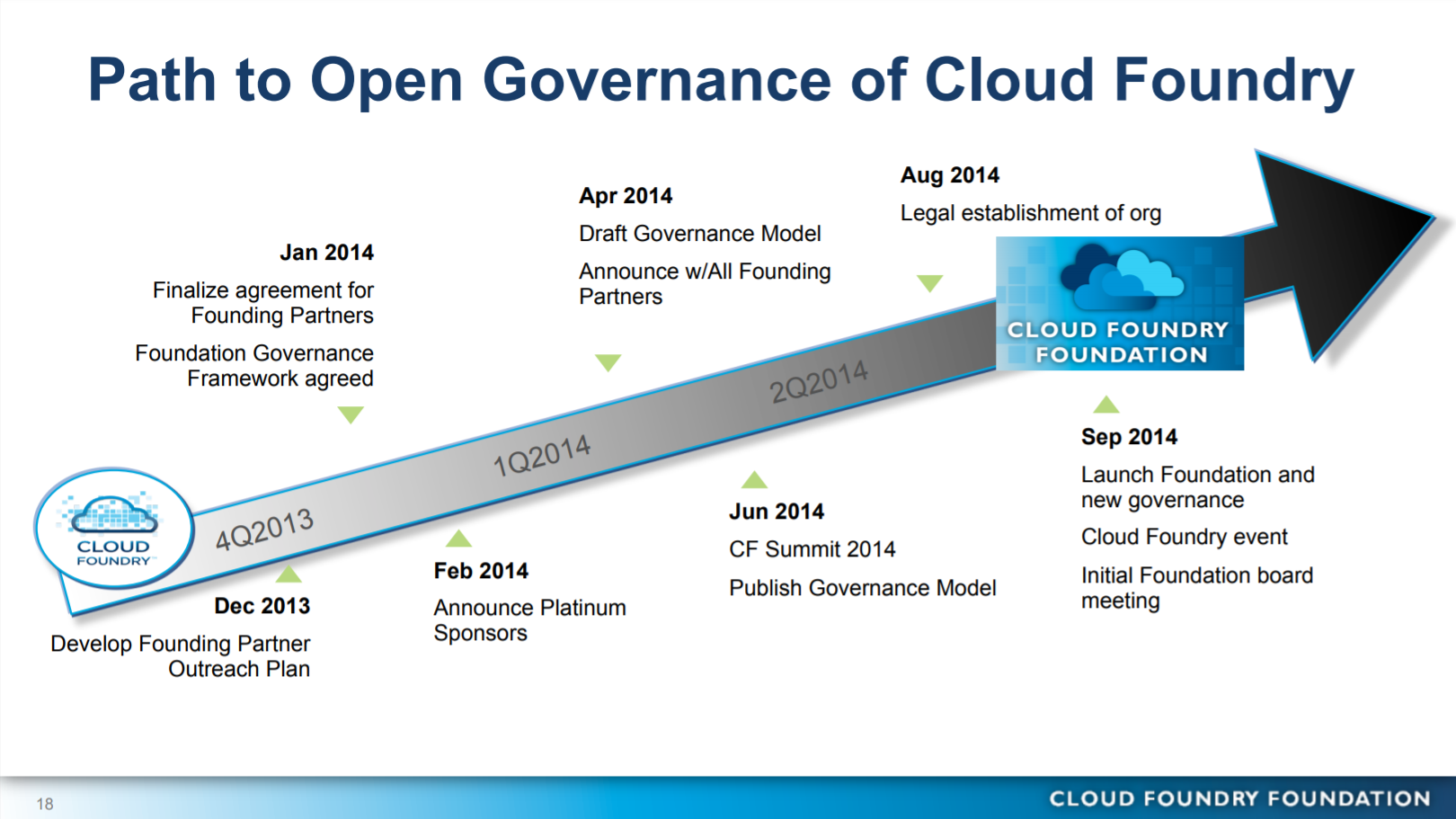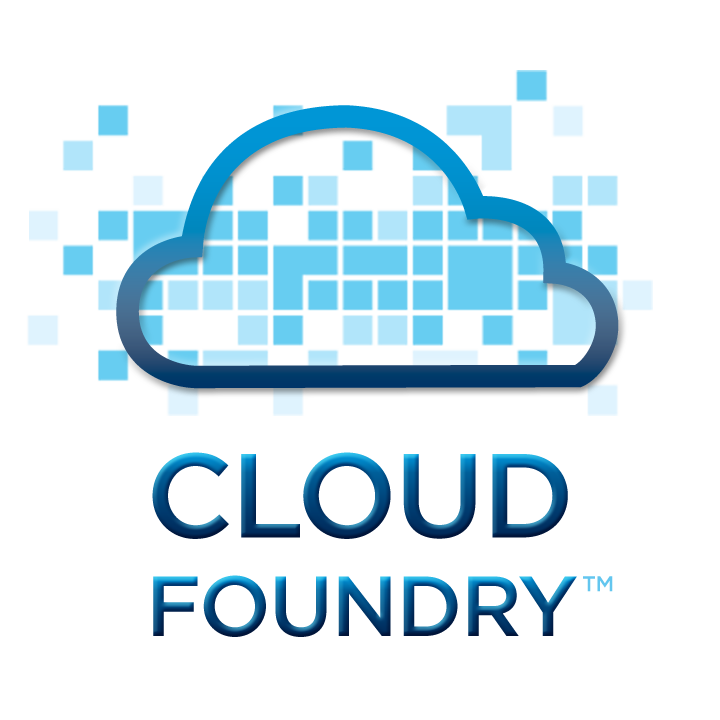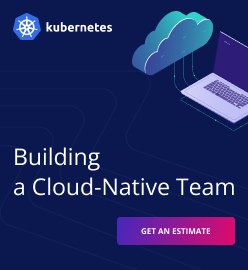The Cloud Foundry Foundation: a PaaS Revolution?


The open-source project Cloud Foundry exploded overnight. Pivotal announced that a group of major IT vendors will form the Cloud Foundry Foundation, a legal entity aimed at providing a formal governance body for the open-source software project. The group united around Cloud Foundry pulls a combined market capitalization of almost half a trillion dollars. IT superpowers have spoken.
What happened today might be the beginning of a new era for IT folks in the vendor ecosystem and their customers.
The facts
- The founding “Platinum sponsors” of the Cloud Foundry Foundation are IBM, HP, Rackspace, SAP, Pivotal, and Pivotal’s parents—VMware and EMC. Each of these companies made a pledge to pay $500,000 per year to the foundation for at least three years. ActiveState and Savvis joined as “Gold sponsors,” pledging $250,000 per year.
- Cloud Foundry is licensed under the Apache License 2.0. This is important because, compared to the General Public License, the Apache License is much more vendor-friendly. It allows for modifications without the requirement to open source these modifications, thus empowering a larger ecosystem of vendors to monetize the code base.
- According to my observations, over the last 12 months, there were around 100 monthly active contributors to the project.
- The size of the project’s code base is no joke. At the moment, it is approaching 600,000 lines of code.
What does this mean for enterprise IT customers?
With this announcement, backers of the foundation are sending their customers a simple message: the traditional way of delivering applications is outdated, and Cloud Foundry will fix it. Here is why. At Altoros, we see three types of customers:
- those that use Cloud Foundry to make money (as the backbone of an innovation engine while they search for or roll out new business models)
- those that use Cloud Foundry to save money (by reducing the cost of compliance or increasing the utilization of infrastructure)
- those that use Cloud Foundry to deliver productivity gains
Capturing these benefits is not an easy job, especially when your IT teams design and manage almost each and every development stack nuts-to-bolts, in most cases—one at a time. What we learned is that the companies who became really good at capturing these benefits are using the PaaS to limit the number of permutations in their development stacks all the way from virtual machines to the applications.
Instead of providing flexibility for each and every stakeholder on each and every layer of an application architecture, they aim to provide a set of pre-defined, pre-approved combinations of runtime environments and database services in the form of APIs, focusing their application development teams on agility and business results.
What are the goals of the Cloud Foundry Foundation?
The goal of the Cloud Foundry Foundation is to promote the development and adoption of Cloud Foundry. Those of you who are bullish on the PaaS technology should read the goal as “to establish the project as a new standard for delivering software applications.”
Was forming the foundation really necessary?
To understand why the Cloud Foundry Foundation was created, let me share with you how the Cloud Foundry project got to where it is today.
- As of fall 2012, the Cloud Foundry project was led by VMware almost single-handedly. At the time, VMware drove adoption of the technology through a handful of small vendors, mainly pushing a hosted “Heroku-style” PaaS offering based on Cloud Foundry. Yet, a few large companies became early adopters of private deployments, including Warner Music Group, Sky, NTT, and Rakuten.
- For the vast majority of enterprise IT folks, any given open source project is not “solvent,” unless it commands a diverse community of active contributors. When it comes to attracting community and contributors, many companies who were interested in sponsoring the Cloud Foundry project faced a competitive conflict of interest with VMware, either directly or indirectly. Because of that conflict of interest, the growth of the Cloud Foundry ecosystem was limited.
- In March 2013, EMC and VMware put together its business units (Cloud Foundry, Pivotal Labs, Greenplum, Spring, and Cetas) and spun them off as a separate company named Pivotal. The company employed a total of 1,250 employees and generated about $300 million in annual revenue. EMC commanded a 69% interest in Pivotal, with the remaining 31% owned by VMware.
- In April 2013, General Electric announced a strategic investment of $105 million in Pivotal. In exchange, GE received 10% of interest in the company. The investment aimed to support GE’s Internet of Things strategy, providing access to technology and talent.
- In July 2013, IBM announced that it was joining the Cloud Foundry project.
- Between July 2013 and December 2013, governance of the project became a community-driven process led by IBM. Some project decisions started to happen in collaboration with representatives of 10+ companies, including ActiveState, Altoros, Anynines, Canonical, IBM, Intel, Piston Cloud, Savvis, and Warner Music Group.
- By the end of 2013, this “community-driven process” became a “working prototype” for the forthcoming Cloud Foundry Foundation.
How will the foundation help vendors and customers?
Speaking the language of the revolution, the foundation offers a set of rules, a legal basis for enforcement of such rules, and—most importantly—guarantees.
Guarantees for vendors. In an industry that changes as fast as ours, building new revenue models with open-source software requires the roadmap of the “project core” to match the strategy of a given vendor. The decisions about what to include or exclude from that “core” are pretty much the currency of the game. Voting rights on every level of the project (from forming a definition of what the “core” is or is not to accepting or denying an individual contribution) is the denomination of that currency.
The charter of the foundation defines, among other things, the currency and its denomination. It specifies in precise detail how the money (decision power and voting rights) is distributed between citizens (various stakeholders in the project). In a nutshell, the foundation provides guarantees to stakeholders in exchange for source code contributions or funding.
- Guarantees for enterprise customers. Enterprise customers, on the one hand, are also building new (or protecting existing) revenue models. They want to avoid vendor lock-in and de-risk long-term technology liabilities. The foundation addresses the requirements of a typical due-diligence process, provides the needed transparency, and naturally pulls the vote of confidence from the conservative side of the enterprise IT.
What does the announcement mean for IT vendors?
Legacy vendors (infrastructure/hardware, software, and hosting) are forced to reinvent their businesses every now and then. The remarkable rise and domination of AWS disrupted many in the vendor ecosystem. Amazon is known for changing the landscape of many (but not all) industries it has played in. Legacy vendors have to move very fast. Cloud Foundry provides a perfect ground for many vendors to unite around a common goal.
Here is what some of the foundation members could do with Cloud Foundry:
- SAP could package Cloud Foundry to an as-a-Service layer above its database, creating a HANA-as-a-Service offering. If it does well, SAP might even build a successor to its NetWeaver business on Cloud Foundry.
- Cloud Foundry may help Rackspace to better fulfill its new mission as a hybrid cloud service provider, delivering a hybrid IaaS/PaaS offering.
- As for IBM, last week, I got a chance to play with IBM Bluemix, a PaaS offering based on Cloud Foundry. Interestingly, Bluemix already contains Liberty, the cloud-ready version of the IBM WebSphere Application Server, single sign-on, and a mobile back-end as a service. It seems like IBM is creating a unified platform for the cloud infrastructure, big data, and their existing middleware business. Cloud Foundry could very well play one of the key roles in their product strategy.
- For HP, Cloud Foundry may help in differentiating its software-defined infrastructure all the way from servers to applications. Its strength could be in the granularity of control, which HP’s customers could have over the form of infrastructure ownership, covering every type of deployment—from legacy to in-house private cloud, to hybrid and public clouds. In a deployment built for one of Altoros’s customers, Cloud Foundry performed remarkably well together with HP’s Moonshot, a next-generation 45-node, $65K–$100K microserver chassis.
One vendor from the Cloud Foundry ecosystem was not present among the members of the foundation. It was Canonical, one of the key beneficiaries of the announcement. Ubuntu, Ubuntu OpenStack, and Cloud Foundry, all enjoy perfect synergies with the exception of conflicting deployment tool chains (Cloud Foundry’s BOSH vs. Canonical’s Juju—both can deploy anything, anywhere). In one of my next posts, I will cover in depth why the union of Cloud Foundry and Ubuntu OpenStack changes the game for many.
The question is, did anyone lose? Well, the PaaS vendors competing with Cloud Foundry just got more work to do, and lots of it. Red Hat will now face even more challenges in building an ecosystem around OpenShift. I really hope that the folks at Red Hat will work with the Cloud Foundry community to standardize around the runtime and services, which are now incompatible. Wouldn’t it be nice to see the cloud moving to the next level of interoperability, at least at the PaaS level?









